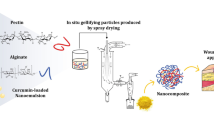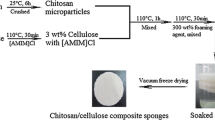Abstract
Burn wound management is a complex process because the damage may extend as far as the dermis which has an acknowledged slow rate of regeneration. This study investigates the feasibility of using hydrogel microparticles composed of bacterial cellulose and polyacrylamide as a dressing material for coverage of partial-thickness burn wounds. The microparticulate carrier structure and surface morphology were investigated by Fourier transform infrared, X-ray diffraction, elemental analysis, and scanning electron microscopy. The cytotoxicity profile of the microparticles showed cytocompatibility with L929 cells. Dermal irritation test demonstrated that the hydrogel was non-irritant to the skin and had a significant effect on wound contraction compared to the untreated group. Moreover, histological examination of in vivo burn healing samples revealed that the hydrogel treatment enhanced epithelialization and accelerated fibroblast proliferation with wound repair and intact skin achieved by the end of the study. Both the in vitro and in vivo results proved the biocompatibility and efficacy of hydrogel microparticles as a wound dressing material.








Similar content being viewed by others
References
Church D, El Sayed S, Reid O, Winston B, Lindsay R. Burn wound infections. Clin Microbiol Rev. 2006;19(2):403–34.
Mogoşanu GD, Grumezescu AM. Natural and synthetic polymers for wounds and burns dressing. Int J Pharm. 2014;463:127–36.
Pham C, Greenwood J, Cleland H, Woodruff P, Maddern G. Bioengineered skin substitutes for the management of burns: a systematic review. Burns. 2007;33:946–57.
Lootens L, Brusselaers N, Beele H, Monstrey S. Keratinocytes in the treatment of severe burn injury: an update. Int Wound J. 2012;10:6–12.
Lin W, Lien C, Yeh H, Yu C, Hsu S. Bacterial cellulose and bacterial cellulose-chitosan membranes for wound dressing applications. Carbohydr Polym. 2013;94:603–11.
Kwak MH, Kim JE, Go J, Koh EK, Song SH, Son HJ, Kim HS, Yun YH, Jung YJ, Hwang DY. Bacterial cellulose membrane produced by Acetobacter sp. A10 for burn wound dressing applications. Carbohyd Polym. 2015;122:387–98.
Huang S, Fu X. Naturally derived materials-based cell and drug delivery systems in skin regeneration. J Control Release. 2010;142:149–59.
Silvestre AJD, Freire CSR, Neto CP. Do bacterial cellulose membranes have potential in drug-delivery systems? Expert Opin Drug Deliv. 2014;11:1113–24.
Czaja W, Krystynowicz A, Bielecki S, Brown Jr RM. Microbial cellulose—the natural power to heal wounds. Biomaterials. 2006;27:145–51.
Backdahl H, Risberg B, Gatenholm P. Observations on bacterial cellulose tube formation for application as vascular graft. Mater. Sci. Eng. C mater. Biol. Appl. 2011;31(1):14–21.
Hennink WE, Van Nostrum CF. Novel crosslinking methods to design hydrogels. Adv Drug Deliv Rev. 2012;64:223–36.
Jovanovic J, Adnadjevic B. Influence of microwave heating on the kinetics of acrylic acid polymerization and crosslinking. J Appl Poly Sci. 2010;116:55–63.
Zhao Z, Zhong L, Qibin X, Hongxia X, Yuesheng L. Fast synthesis of temperature-sensitive PNIPAAm hydrogels by microwave irradiation. Eur Poly J. 2008;44:1217–24.
Pandey M, Mohamad N, Amin MCIM. Bacterial cellulose/acrylamide pH-sensitive smart hydrogel: development, characterization, and toxicity studies in ICR mice model. Mol Pharm. 2014;11:3596–608.
Amin MCIM, Abadi AG, Katas H. Purification, characterization and comparative studies of spray-dried bacterial cellulose microparticles. Carbohydr Polym. 2014;99:180–9.
Ahmad N, Amin MCIM, Mahali SM, Ismail I, Chuang VTG. Biocompatible and mucoadhesive bacterial cellulose-g-poly (acrylic acid) hydrogels for oral protein delivery. Mol Pharm. 2014;11:4130–42.
Amjad MW, Amin MCI, Katas H, Butt AM. Doxorubicin-loaded cholic acid polyethyleneimine micelles for targeted delivery of antitumor drugs: synthesis, characterization, and evaluation of their in-vitro cytotoxicity. Nanoscale Res Lett. 2012;7:687–789.
Loo Y, Wong Y, Cai EZ, Ang C, Raju A, Lakshmanan A, Koh AG, Zhou HJ, Lim T, Moochhala SM, Hauser CAE. Ultrashort peptide nanofibrous hydrogels for the acceleration of healing of burn wounds. Biomaterials. 2014;35:1–10.
Alsarra IA. Chitosan topical gel formulation in the management of burn wounds. Int J Biol Macromol. 2009;45:16–21.
Amin MCIM, Ahmad N, Halib N, Ahmad I. Synthesis and characterization of thermo and pH responsive bacterial cellulose/acrylic acid hydrogel for drug delivery. Carbohydr Polym. 2012;88:465–73.
Pandey M, Amin MCI, Ahmad N, Abeer MM. Rapid synthesis of superabsorbent smart-swelling bacterial cellulose/acrylamide-based hydrogels for drug delivery. Int J Polym Sci. 2013;2013:1–10.
Song Y, Zhou J, Zhang L, Wu X. Homogenous modification of cellulose with acrylamide in NaOH/urea aqueous solutions. Carbohydr Polym. 2008;73:18–25.
Marandi GB, Esfandiari K, Biranvand F, Babapour M, Sadeh S, Mahdavinia GR. pH sensitivity and swelling behavior of partially hydrolyzed formaldehyde-crosslinked poly (acrylamide) superabsorbent hydrogels. J App Polym Sci. 2008;109:1083–92.
Kumar A, Singh K, Ahuja M. Xanthan-g-poly (acrylamide): microwave assisted synthesis, characterization and in-vitro release behavior. Carbohydr Polym. 2009;76:261–7.
Sutar PB, Mishra RK, Pal K, Banthia AK. Development of pH sensitive polyacrylamide grafted pectin hydrogel for controlled drug delivery system. J Mater Sci Mater Med. 2008;19:2247–53.
Vijan V, Kaity S, Biswas S, Isaac J, Ghosh A. Microwave assisted synthesis and characterization of acrylamide grafted gellan, application in drug delivery. Carbohydr Polym. 2012;90:496–506.
Ibrahim M, El S, Mamdouh AM, Abdel AM, Dawidar AM, Hugh DCS. Biodegradable pH-responsive alginate-poly (lactic-co-glycolic acid) nano/micro hydrogel matrices for oral delivery of silymarin. Carbohydr Polym. 2011;83:1345–54.
Liu X, Tang M, Zhang T, Hu Y, Zhang S, Kong L, Xue Y. Determination of a threshold dose to reduce or eliminate cdte-induced toxicity in l929 cells by controlling the exposure dose. PLoS One. 2013;8:e59359. doi:10.1371/journal.pone.0059359.
Baek HS, Ja YY, Dong WH, Dong HL, Oh-Hun K, Jong-Chul P. Evaluation of the extraction method for the cytotoxicity testing of latex gloves. Yonsei Med J. 2005;46:579–83.
Almeida IF, Pereira T, Silva NHCS. Bacterial cellulose membranes as drug delivery systems: an in vivo skin compatibility study. Eur J Pharm Biopharm. 2014;106:264–9.
Muangman P, Opasanon S, Suwanchot S, Thangthed O. Efficiency of microbial cellulose dressing in partial-thickness burn wounds. J Am Col Certif Wound Spec. 2011;27; 3(1):9–16.
Cai Z, Kim J. Bacterial cellulose/poly(ethylene glycol) composite: characterization and first evaluation of biocompatibility. Cellulose. 2010;17(1):83–91.
Anon. Amended final report on the safety assessment of polyacrylamide and acrylamide residues in cosmetics. Int J Toxicol. 2005;2:21–50.
Boateng JS, Matthews KH, Stevens HNE, Eccleston GM. Wound healing dressings and drug delivery systems: a review. J Pharm Sci. 2008;97:2892–923.
Junker JPE, Kamel RA, Caterson EJ, Eriksson E. Clinical impact upon wound healing and inflammation in moist, wet, and dry environments. Adv Wound Care. 2013;2:348–56.
Mohamad N, Amin MCIM, Pandey M, Ahmad N, Rajab N. Bacterial cellulose/acrylic acid hydrogel synthesized via electron beam irradiation: accelerated burn wound healing in an animal model. Carbohyd Polym. 2014;114:312–20.
Tepole AB, Kuhl E. Systems-based approaches toward wound healing. Pediatr Res. 2013;73:553–63.
Chen S, Tsao C, Chang C, Lai Y, Wu M, Chuang C, Chou H, Wang C, Hsieh K. Assessment of reinforced poly (ethylene glycol) chitosan hydrogels as dressings in a mouse skin wound defect model. Mater Sci Eng C, Mater Biol Appl. 2013;33:2584–94.
Acknowledgments
The authors would like to thank the Ministry of Higher Education, Malaysia (UKM-Farmasi-02-FRGS0192-2010) and the Universiti Kebangsaan Malaysia (INOVASI-2013-005) for their financial assistance and support.
Author information
Authors and Affiliations
Corresponding author
Ethics declarations
Conflict of interest
The authors declare that they have no conflict of interest.
Rights and permissions
About this article
Cite this article
Pandey, M., Mohamad, N., Low, WL. et al. Microwaved bacterial cellulose-based hydrogel microparticles for the healing of partial thickness burn wounds. Drug Deliv. and Transl. Res. 7, 89–99 (2017). https://doi.org/10.1007/s13346-016-0341-8
Published:
Issue Date:
DOI: https://doi.org/10.1007/s13346-016-0341-8




